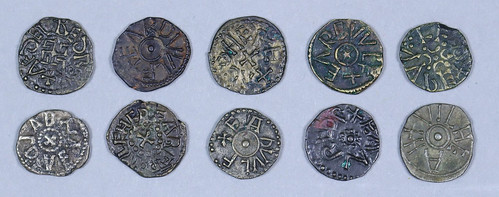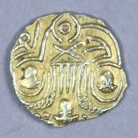
PREV ARTICLE
NEXT ARTICLE
FULL ISSUE
PREV FULL ISSUE
JOHN CROSS COLLECTION OF ANGLO-SAXON COINSDavid Pickup passed along this article about the John Cross Collection of Anglo-Saxon Coins offered by the Canterbury Auction Galleries. Thanks. -Editor When the executors began clearing the contents of a Canterbury pensioner's park home following his death last year, they discovered he had quietly amassed a sizeable collection of early Anglo-Saxon coins so valuable they were kept in a bank vault for safekeeping. When they were examined by the numismatic consultant at The Canterbury Auction Galleries, he described them as among the most important collection of Anglo-Saxon coins outside any UK museum. The collection, which is expected to raise a total of around £75,000, will be dispersed in a sale on October 2-4, with the proceeds going to two charities according to his wishes.
Records found in his park home showed he amassed his collection over a 20-30 year period, spending particularly freely between 2016 and 2017. It became so extensive and valuable that the coins were held in the bank for safe keeping. The proceeds from the sale will go to the The British Numismatic Society and Friends of Kent Churches, as he wished. The auctioneers, meanwhile, are producing a separate catalogue of the collection at their expense.
The collection is rich in coins with a connection to Canterbury. A silver penny with the head of an Archbishop and dating from 757-796 is estimated at £2,000-2,500, as is another circa 780, showing the head of the King of Kent. Cuthred, King of Kent, is recalled by a portrait silver penny dated from 798-807, the same estimate being given to another silver penny struck in 805-832, when Wulfred was Archbishop (each £1,800-2,000). Another, struck for Baldred, King of Kent dating from 823-825 is estimated at £1,000-1,500, as is another dating from 833-870, for Archbishop Ceolnoth. Among many silver pennies in the collection, examples include one from 796-821 for Coenwulf (estimate £800-1,000) and 823-825 for Beornwulf (1,500-2,000); another dating from 840-852 for Beorhtwulf (1,200-1,500); 899-924 for Edward the Elder (£1,000-1.500); 924-939 for Athelstan (£2,000-3,000), while from 1066 – a date every pupil of English history knows – is a silver penny for King Harold II, killed at the Battle of Hastings. It is estimated at £1,500-2,000.
To read the complete article, see:
Wayne Homren, Editor The Numismatic Bibliomania Society is a non-profit organization promoting numismatic literature. See our web site at coinbooks.org. To submit items for publication in The E-Sylum, write to the Editor at this address: whomren@gmail.com To subscribe go to: https://my.binhost.com/lists/listinfo/esylum All Rights Reserved. NBS Home Page Contact the NBS webmaster 
|


